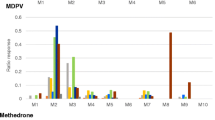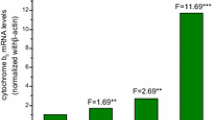Abstract
Methyl t-butyl ether (MTBE) and ethyl t-butyl ether (ETBE) are commonly used in unleaded gasoline to increase the oxygen content of fuel and to reduce carbon monoxide emissions from motor vehicles. This study was undertaken to investigate: (1) the effect of administration to rats of ETBE and its metabolite, t-butanol, on the induction and/or inhibition of hepatic P450 isoenzymes; (2) the oxidative metabolism of MTBE and ETBE by liver microsomes from rats pretreated with selected P450 inducers and purified rat P450(s), (2B1, 2E1, 2C11, 1A1). ETBE administration by gavage at a dose of 2 ml/kg for 2 days induced hepatic microsomal P4502E1-linked p-nitrophenol hydroxylase and the P4502B1/2-associated PROD and 16β-testosterone hydroxylase, verified by immunoblot experiments. t-Butanol treatments at doses of 200 and 400 mg/kg i. p. for 4 days did not alter any liver microsomal monoxygenases. Both MTBE and ETBE were substrates for rat liver microsomes and were oxidatively dealkylated to yield formaldehyde and acetaldehyde, respectively. The dealkylation rates of both MTBE and ETBE were increased c. fourfold in phenobarbital (PB)-treated rats. In rats pretreated with pyrazole, an inducer of 2E1, only the demethylation of MTBE was increased (c. twofold). When the oxidations of MTBE and ETBE were investigated with purified P450(s) in a reconstituted system, it was found that P4502B1 had the highest activities towards both solvents, whereas 1A1 and 2C11 were only slightly active; P4502E1 had an appreciable activity on MTBE but not against ETBE. Metyrapone, a potent inhibitor of P450 2B, consistently inhibited both the MTBE and ETBE dealkylations in microsomes from PB-treated rats. Furthermore, 4-methylpyrazole (a probe inhibitor of 2E1) and anti-P4502E1 IgG showed inhibition, though modest, only on MTBE demethylation, but not on ETBE deethylation. Inhibition experiments have also suggested that rat 2A1 may exert an important role in MTBE and ETBE oxidation. Taken together, these results indicate that 2B1, when expressed, is the major enzyme involved in the oxidation of these two solvents and that 2E1 may have a role, although minor, in MTBE demethylation. The implications of these data for MTBE and ETBE toxicity remain to be established.
Similar content being viewed by others
Author information
Authors and Affiliations
Additional information
Received: 5 August 1997 / Accepted: 29 October 1997
Rights and permissions
About this article
Cite this article
Turini, A., Amato, G., Longo, V. et al. Oxidation of methyl- and ethyl- tertiary-butyl ethers in rat liver microsomes: role of the cytochrome P450 isoforms. Arch Toxicol 72, 207–214 (1998). https://doi.org/10.1007/s002040050490
Issue Date:
DOI: https://doi.org/10.1007/s002040050490




